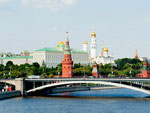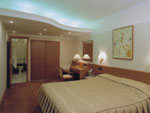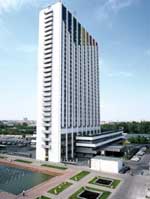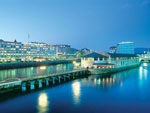 The Moscow Kremlin, perhaps, is the most important symbol of capital of Russia. It is the largest fortress of Europe which not only was preserved, but also remains functioning until now. Being the centre of a political and religious life in Russia, it casually serves as presidential residence. In outward appearance, the Kremlin looks as unequal triangle with the area of 27.5 hectare surrounded by a high red brick fortification. The Kremlin is a de-facto centre of Moscow, and is located on the Borovitsky hill, on the left coast of the Moscow River.
The Moscow Kremlin, perhaps, is the most important symbol of capital of Russia. It is the largest fortress of Europe which not only was preserved, but also remains functioning until now. Being the centre of a political and religious life in Russia, it casually serves as presidential residence. In outward appearance, the Kremlin looks as unequal triangle with the area of 27.5 hectare surrounded by a high red brick fortification. The Kremlin is a de-facto centre of Moscow, and is located on the Borovitsky hill, on the left coast of the Moscow River.
The southern wall of the Kremlin triangle is turned to the river, eastern side - to Red Square, northwest - to Aleksandrovsky garden. For visitors the Kremlin is opened from the direction of Aleksandrovsky garden fronted by Troitsk tower. By the way, this tower is the highest (80 meters) among the rest 20 towers towering over a fortification of the Kremlin.
Today it represents a huge complex of temples, palaces and the other buildings surrounded with a massive wall, while everything started with a small wooden fortress. The first settlements in the Kremlin go back to 2nd millennium B.C., evidenced by remains of Finno-Ugric settlement discovered nearby the Arkhangelsk cathedral and dating back to the 1st millennium B.C. However, 1147 is considered the official year of the foundation of Moscow, and first wooden fortifications sprang in territory of the Kremlin in 1156. Every so often, because of the attacks of nomads, the walls of the Kremlin were destroyed and built up again. Gradually, the area of a fortress increased as a result of these reorganizations.
In 1367, after a huge fire that burnt half of Moscow, the white stone instead of wood was used in the reconstruction of the Kremlin, and thus Moscow was nicknamed ‘white-stoned’. A century later, in the second half of the 15th century, a fortress basically acquired its present look, in 1485-1495 new walls were revetted by a red brick. The façade of the Kremlin remained intact throughout five centuries up to present days.
The period from the 17th to 19th century marked the construction of almost all interior buildings of the Kremlin : Teremnoy Palace was finished in 1636, Arsenal was built in 1702-1736, the Senate was built in 1776- 1787. In 1812, when Moscow was captured by Napoleon, most part of the building underwent severe damages, some constructions were lost forever. It took over 20 years to reconstruct the Kremlin.
The rise of the Soviet power became the most destructive period for the history of the Kremlin. The fortress suffered artillery bombardment in October, 1917. At the same time, the proclamation of Moscow the capital of USSR in 1918 ushered in the destruction of religious and monarchic monuments. Monarchy symbols were replaced with symbols of communistic Russia - a star, and also a sickle and a hammer.
The Kremlin Palace of Congresses was constructed in 1959-1961. The Kremlin was turned into one large museum and was opened for visiting by tourists. By the way, up to 1961 the territory of the Kremlin was inhabited by people. In 1990 UNESCO listed the Moscow Kremlin in its World Heritage list.
Going to Moscow and not visiting the Kremlin and Red Square is travelling for nothing. Do not miss such chance if you are in Moscow. Moscow Kremlin is heart of the state, that behind impenetrable ‘Iron Curtain’ as far back as thirty years ago. The Kremlin is a half of history of Russia.







